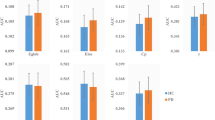Abstract
Neuro-degenerative diseases such as Parkinson’s Disease (PD) are clinically found to cause alternations and failures in brain connectivity. In this work, a new classification framework using dynamic functional connectivity and topological features is proposed, and it is shown that such framework can give better insights over discriminative difference of the disease itself. After utilizing sparse group lasso with anatomically labeled resting-state fMRI signal, both discriminating brain regions and voxels within can be identified easily. To give an overview of the effectiveness of such framework, the classification performance with the network features extracted on dynamic functional network is quantitatively evaluated. Experimental results show that either single feature of clustering coefficient or combined feature group of characteristic path length, diameter, eccentricity and radius perform well in classifying PD, and as a result the identified feature can lead to better interpretation for clinical purposes.
Access this chapter
Tax calculation will be finalised at checkout
Purchases are for personal use only
Similar content being viewed by others
Notes
- 1.
1 TR represents the time between two successive data points in the time-series signal.
- 2.
Mathematically, \(t_i=\frac{1}{2}\sum _{j,h\in N}a_{ij}a_{ih}a_{jh}\), where \(a_{ij}\) is the connection status between i and j: \(a_{ij} = 1\) when link (i, j) exists (when i and j are neighbors); \(a_{ij} = 0\) otherwise (\(a_{ii} = 0\) for all i).
- 3.
From the formula, C is only defined when \(k_i\) is larger than 1.
- 4.
Mathematically, \(t_i^w = \frac{1}{2}\sum _{j,h\in N}(w_{ij}w_{ih}w_{jh})^{1/3}\), where \(w_{ij}\) is the connection weight between nodes i and j.
References
Aftabuddin, M., Kundu, S.: AMINONET-a tool to construct and visualize amino acid networks, and to calculate topological parameters. J. Appl. Crystallogr. 43(2), 367–369 (2010)
Arenas, A., Díaz-Guilera, A., Kurths, J., Moreno, Y., Zhou, C.: Synchronization in complex networks. Phys. Rep. 469(3), 93–153 (2008)
Börner, K., Sanyal, S., Vespignani, A.: Network science. Ann. Rev. Inf. Sci. Technol. 41(1), 537–607 (2007)
Byun, H.Y., Lu, J.J., Mayberg, H.S., Günay, C.: Classification of resting state fMRI datasets using dynamic network clusters. In: Workshops at the Twenty-Eighth AAAI Conference on Artificial Intelligence (2014)
Chai, B., Walther, D., Beck, D., Fei-Fei, L.: Exploring functional connectivities of the human brain using multivariate information analysis. In: Advances in Neural Information Processing Systems, pp. 270–278 (2009)
Cortes, C., Vapnik, V.: Support-vector networks. Mach. Learn. 20(3), 273–297 (1995)
Estrada, E.: The Structure of Complex Networks: Theory and Applications. Oxford University Press, New York (2012)
Matthew Hutchison, R., et al.: Dynamic functional connectivity: promise, issues, and interpretations. Neuroimage 80, 360–378 (2013)
Ioannides, A.A.: Dynamic functional connectivity. Curr. Opin. Neurobiol. 17(2), 161–170 (2007)
Lancaster, J.L., et al.: Automated talairach atlas labels for functional brain mapping. Hum. Brain Mapp. 10(3), 120–131 (2000)
Lancaster, J.L., et al.: Automated labeling of the human brain: a preliminary report on the development and evaluation of a forward-transform method. Hum. Brain Mapp. 5(4), 238 (1997)
Liu, J., Ji, S., Ye, J., et al.: SLEP: sparse learning with efficient projections. Arizona State Univ. 6, 491 (2009)
Loewe, K., Grueschow, M., Stoppel, C.M., Kruse, R., Borgelt, C.: Fast construction of voxel-level functional connectivity graphs. BMC Neurosci. 15(1), 1 (2014)
Duncan Luce, R., Perry, A.D.: A method of matrix analysis of group structure. Psychometrika 14(2), 95–116 (1949)
Madhyastha, T.M., Askren, M.K., Boord, P., Grabowski, T.J.: Dynamic connectivity at rest predicts attention task performance. Brain Connectivity 5(1), 45–59 (2015)
Norman, K.A., Polyn, S.M., Detre, G.J., Haxby, J.V.: Beyond mind-reading: multi-voxel pattern analysis of fMRI data. Trends Cogn. Sci. 10(9), 424–430 (2006)
Onnela, J.-P., Saramäki, J., Kertész, J., Kaski, K.: Intensity and coherence of motifs in weighted complex networks. Phys. Rev. E 71(6), 065103 (2005)
Opsahl, T.: Triadic closure in two-mode networks: redefining the global and local clustering coefficients. Soc. Netw. 35(2), 159–167 (2013)
Opsahl, T., Panzarasa, P.: Clustering in weighted networks. Soc. Netw. 31(2), 155–163 (2009)
Papo, D., Buldú, J.M., Boccaletti, S., Bullmore, E.T.: Complex network theory and the brain. Phil. Trans. R. Soc. B 369(1653), 20130520 (2014)
Peng, H., Long, F., Ding, C.: Feature selection based on mutual information criteria of max-dependency, max-relevance, and min-redundancy. IEEE Trans. Patt. Anal. Mach. Intell. 27(8), 1226–1238 (2005)
Power, J.D., et al.: Functional network organization of the human brain. Neuron 72(4), 665–678 (2011)
Richiardi, J., Eryilmaz, H., Schwartz, S., Vuilleumier, P., Van De Ville, D.: Decoding brain states from fmri connectivity graphs. Neuroimage 56(2), 616–626 (2011)
Rubinov, M., Sporns, O.: Complex network measures of brain connectivity: uses and interpretations. Neuroimage 52(3), 1059–1069 (2010)
Strogatz, S.H.: Exploring complex networks. Nature 410(6825), 268–276 (2001)
Telesford, Q.K., Joyce, K.E., Hayasaka, S., Burdette, J.H., Laurienti, P.J.: The ubiquity of small-world networks. Brain Connectivity 1(5), 367–375 (2011)
Van Wijk, B.C.M., Stam, C.J., Daffertshofer, A.: Comparing brain networks of different size and connectivity density using graph theory. PloS ONE 5(10), e13701 (2010)
Varoquaux, G., Gramfort, A., Poline, J.-B., Thirion, B.: Brain covariance selection: better individual functional connectivity models using population prior. In: Advances in Neural Information Processing Systems, pp. 2334–2342 (2010)
Wang, Z., Alahmadi, A., Zhu, D., Li, T.: Brain functional connectivity analysis using mutual information. In: 2015 IEEE Global Conference on Signal and Information Processing (GlobalSIP), pp. 542–546. IEEE (2015)
Watts, D.J., Strogatz, S.H.: Collective dynamics of śmall-worldńetworks. Nature 393(6684), 440–442 (1998)
Author information
Authors and Affiliations
Corresponding author
Editor information
Editors and Affiliations
Rights and permissions
Copyright information
© 2018 Springer Nature Switzerland AG
About this paper
Cite this paper
Puk, K.M. et al. (2018). Uncovering Dynamic Functional Connectivity of Parkinson’s Disease Using Topological Features and Sparse Group Lasso. In: Wang, S., et al. Brain Informatics. BI 2018. Lecture Notes in Computer Science(), vol 11309. Springer, Cham. https://doi.org/10.1007/978-3-030-05587-5_40
Download citation
DOI: https://doi.org/10.1007/978-3-030-05587-5_40
Published:
Publisher Name: Springer, Cham
Print ISBN: 978-3-030-05586-8
Online ISBN: 978-3-030-05587-5
eBook Packages: Computer ScienceComputer Science (R0)




